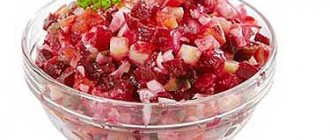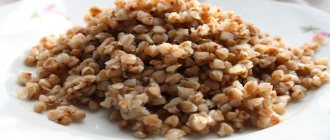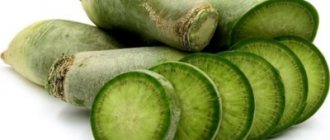What are the benefits of vegetable salad?
How many calories are in a vegetable salad, what beneficial properties it has, all this is of great interest to those who lead a healthy lifestyle and monitor their health and figure. So we will try to answer these questions in the next article.
Vegetable salad is certainly a healthy and versatile dish. After all, it is common knowledge that fresh vegetables are a rich source of fiber, mineral components, vitamins and other substances we need.
Vegetable salad can act as an independent dish. It would be a good option, for example, for breakfast. People who want to lose weight or get rid of excess weight should pay attention to it. If at lunch you prefer a vegetable salad as a first course, then you will feel full sooner and, therefore, you will eat less.
But this, of course, does not mean that you can eat salads in unlimited quantities. After all, vegetables also contain a certain amount of calories. You should also remember that not every vegetable is suitable for a salad if the goal is to lose weight.
To reduce the calorie content of a dish, choose raw vegetables for it: their calorie content is lower than that of stewed vegetables, and they contain more vitamins and minerals, because some of the nutrients are lost during cooking.
The main criterion for selecting vegetables for salad is their juiciness. They contain more liquid, therefore they will contain fewer calories.
Calorie content of vegetable salad. Chemical composition and nutritional value.
Nutritional value and chemical composition of “vegetable salad”.
The table shows the nutritional content (calories, proteins, fats, carbohydrates, vitamins and minerals) per edible portion.
| Nutrient | Quantity | Norm** | % of the norm in 100 g | % of the norm in 100 kcal | 100% normal |
| Calorie content | 45 kcal | 1684 kcal | 2.7% | 6% | 3742 g |
| Squirrels | 2 g | 76 g | 2.6% | 5.8% | 3800 g |
| Carbohydrates | 8 g | 219 g | 3.7% | 8.2% | 2738 g |
The energy value of vegetable salad is 45 kcal.
Primary Source: Created in the application by the user. Read more.
** This table shows the average levels of vitamins and minerals for an adult. If you want to know the norms taking into account your gender, age and other factors, then use the “My Healthy Diet” application.
health-diet.ru
How many calories are in a vegetable salad?
Prepare the salad according to this recipe:
Products (for 4 servings):
- White cabbage – 300 g. – (81 kcal)
- Fresh cucumbers - 2 pcs. — (39 kcal)
- Red bell pepper - 1 pc. — (27 kcal)
- Yellow bell pepper - 1 pc. — (27 kcal)
- Parsley - to taste
- Vegetable oil - 4 tbsp. l. — (576 kcal)
- Salt - to taste
- Sugar - 1 tsp. — (27 kcal)
- Vinegar - 0.5-1 tbsp. l.
How to cook:
- We clean the cabbage from the outer rough leaves and wash it. chop finely, sprinkle with salt and, lightly rubbing with your hands, place in a salad bowl.
- Wash the peppers, remove the seeds, cut into half rings and place in a salad bowl with the cabbage.
- Wash the cucumbers, cut them into thin half rings, and put them in a salad bowl.
- Wash the greens, chop them finely and put them in a salad bowl.
- For dressing, mix sunflower oil, vinegar and sugar.
- Season the salad and mix.
Based on the posted recipe:
The calorie content of vegetable salad with oil, per 100 grams, is:
Iceberg lettuce: nutritional value
Among the many varieties of green salad
Iceberg
is especially popular due to its low
calorie content
and high content of healthy elements and vitamins. The composition of this product is enriched with fiber, folic acid and many other microelements.
Many diet followers highly value Iceberg salad, which contains 100 calories
a gram of it is only 14 kcal. If we talk about energy value, then 0.1 g is fat, 0.9 g is protein and 1.8 g is carbohydrates.
Most of the composition of this green salad is water (96%). In addition, lettuce leaves contain dietary fiber, saturated fatty acids, polysaccharides, disaccharides, phytoncides, ash, and alkaloid compounds that are beneficial to the body.
Iceberg salad is also not deprived of a vitamin and mineral complex. When fresh, it contains a rich amount of retinol, ascorbic acid, B vitamins, beta-carotene, tocopherol and many others.
Among other types of greens, Iceberg is also distinguished by its capacity of vitamin K, another name for which is phylloquinone. This component stabilizes the functioning of almost all systems and organs.
The presence of minerals is also exciting, in particular phosphorus, sodium, potassium, zinc, copper, manganese, iron, selenium and others.
Given the low calorie content
and a very pleasant taste, you can eat
Iceberg salad
without any restrictions and at the same time diversify any dietary food.
Calorie content of vegetables
Vegetables are an ideal option for a diet. It is not for nothing that they often form the basis of the diet of those who strive to get their body in good shape. A huge variety of vegetables allows you to plan your diet in such a way that the same dish will not be repeated throughout the week. Eating fresh vegetables will saturate the body with essential vitamins, macro- and microelements, dietary fiber and healthy acids. Most fruits are extremely effective in losing weight and have a lot of qualities and properties that improve the functioning of the body during the diet. Finally, the caloric content of vegetables is very low, which allows you to eat them in large quantities and prevent the feeling of hunger .
Benefits and calorie content of vegetables
Vegetables are record holders for the amount of fiber, fiber and complex carbohydrates. It is the word “carbohydrates” in vegetables that sometimes scares away those losing weight. On the one hand, carbohydrates are the most nutritious nutrient after fats, and as a result the most dangerous, since they are relatively easily deposited in the most unnecessary places. However, this is only part of the information, which mostly concerns simple carbohydrates. Complex carbohydrates, which include starch, glycogen, cellulose, take longer to digest, cause less insulin release into the blood, and therefore are almost not converted by the body into fat deposits. Vegetables owe all their already low calorie content to the content of complex carbohydrates.
To understand what benefits each vegetable brings, you need to determine the types of complex saccharides that make up them.
Soluble dietary fiber is found in peas and beans. Calorie content of vegetables in 100 grams, respectively: 55 kcal and 16 kcal . When these fibers enter the intestines, they are converted into a gel, which, by preventing the rapid movement of food through the intestines, slows down the absorption of carbohydrates. Some pectins, also a type of soluble fiber, reduce the absorption of sugar and fat in the intestine and lower cholesterol concentrations. Calorie content of vegetables that contain pectin: carrots - 35 kcal per 100 g, cauliflower - 30 kcal, potatoes - 77 kcal.
Vegetable salads for weight loss
It is better to prepare a vegetable salad in such a way that the components contain both soluble and insoluble fiber. For example, the calorie content of a vegetable salad made from radishes, cucumbers, and carrots without adding oil is about 50 kcal. By adding a tablespoon of olive oil, you can significantly improve the taste of the dish, slightly increasing the calorie content of the vegetable salad - up to 70-80 kcal.
Very satisfying, tasty, nutritious and healthy - warm bean and potato salad. Cut the boiled potatoes into small cubes, cook the red beans, adding garlic (149 kcal per 100 g) and herbs to taste. How many calories are in vegetables in this salad? In total, no more than 130 kcal per 100 g . Despite the relatively high calorie content for a vegetable salad, this dish will relieve hunger for a long time, help get rid of constipation, and improve intestinal motility.
A light salad for dinner includes vegetables whose calorie content is minimal: dill, cucumber, sweet pepper, tomatoes (20 kcal per 100 g). How many calories are in the vegetables included in this salad? This is the most dietary option for dinner, the calorie content of which is about 40 kcal. To taste, you can add sunflower, olive or incredibly healthy flaxseed oil, then the calorie content of the vegetable salad will increase to 60 kcal.
Another option for a warm salad: lettuce leaves (16 kcal per 100 g), boiled green beans (16 kcal), juice of half a lemon, cherry tomatoes (20 kcal), stewed zucchini (24 kcal), mix carefully, add a spoonful of olive oil and enjoy An ideal vegetable salad for weight loss.
The benefits of salads for weight loss
Any nutritionist will tell you that anyone who wants to reduce their weight noticeably and for a long time needs to start eating healthy. And a healthy diet necessarily includes the oldest dish of world cuisine - salad. Of course, preference should be given to vegetable salads with low calorie content.
When losing weight, a vegetable salad performs several functions at once - it satisfies the feeling of hunger and fills the stomach, nourishes the body with useful microelements and vitamins, and also serves as a kind of “broom” - it cleanses the intestines and improves metabolism. As with everything, you need to approach the preparation of salads wisely and lovingly.
In spring, summer and autumn, it is advisable to choose vegetables for salad at the market, and not in the supermarket. In winter, it is better to “click” on sauerkraut with onions - a rich storehouse. Season with vegetable oil and you can safely eat a fairly large portion. Neither excess weight nor colds will bother you.
How many calories are in home-cooked vegetables?
Due to their low calorie content, vegetables are suitable for any type of preparation . They can be boiled, baked, steamed, stewed and even fried. The last cooking method is the least recommended because it is the most high-calorie. And no matter how many calories there are in a vegetable, when fried, this amount triples.
It was found that stewing is the ideal way to cook vegetables. Firstly, this preserves the maximum vitamins, appearance and rich taste of vegetables. Secondly, the calorie content of stewed vegetables is slightly higher than the calorie content of fresh ones, but remains low, and their use will not affect the shape.
Vegetables should be stewed without oil. You can eliminate the blandness by adding a little salt, black pepper, and lean meat. The result is a hearty and dietary stew.
All vegetables are suitable for stewing; calorie content does not matter . The only exception would probably be potatoes. Compared to the general background, it looks too nutritious.
Calorie content of stewed vegetables:
- eggplant – 60 kcal per 100 g;
- carrots – 32 kcal per 100 g;
- green beans – 48 kcal per 100 g;
- zucchini – 48 kcal per 100 g;
- onions – 41 kcal per 100 g;
- cabbage – 43 kcal per 100 g.
Vegetable salad calorie content per 100
Vegetable salad, the calorie content of which we will consider in today’s publication, is certainly a healthy and versatile dish. After all, it is common knowledge that fresh vegetables are a rich source of fiber, mineral components, vitamins and other substances we need.
Vegetable salad can act as an independent dish. It would be a good option, for example, for breakfast. People who want to lose weight or get rid of excess weight should pay attention to it. If at lunch you prefer a vegetable salad as a first course, then you will feel full sooner and, therefore, you will eat less.
But this, of course, does not mean that you can eat salads in unlimited quantities. After all, vegetables also contain a certain amount of calories. You should also remember that not every vegetable is suitable for a salad if your goal is to lose weight.
Calorie content of vegetables most beneficial for weight loss
So, finally, we will tell you the healthiest vegetables that will help you in the fight against excess weight.
The first vegetable is carrots. It is low in fat and calories, incredibly tasty, and can lower blood cholesterol levels. The root vegetable contains vitamins C, A, B6, K, fiber, and iron. Eat raw carrots in salads every day and you will be healthy. The calorie content of the vegetable is 32 kcal per 100 g.
Next on the list is spinach. Remember the cartoon about Popeye the Sailor? He loved spinach, and for good reason! This is a whole storehouse of calcium, healthy vitamins, iron and copper. There are very few calories in the vegetable, so without a doubt you can eat spinach as much as you want!
Broccoli is another product for a healthy diet and weight loss. How many calories are in a vegetable? The calorie content of broccoli is 28 kcal per 100 g. It is tasty both raw and cooked. Broccoli contains a lot of vitamin E, A, C, K, B6, and fiber.
Pumpkin has an excellent taste both cooked and fresh. The calorie content of the vegetable is 21 kcal per 100 g. Pumpkin contains a minimum of cholesterol, sugar and fat, but it is rich in microelements and vitamins.
The next very useful vegetable is onion. Of course, it is not always pleasant to eat. But adding raw onions to salads will add piquancy to the dish and help you lose weight. Onions contain vitamins K, B6, C, fiber, and folic acid. In addition, onions are a natural antiseptic. How many calories are in a vegetable? Only 38 calories per 100 g.
Cooked, fresh or canned tomatoes are an excellent food for weight loss. And you don't have to worry about veggie calories, fat, or cholesterol! Tomato contains many microelements, vitamins, and fiber. Therefore, eat tomatoes and lose weight for your health!
The next useful product is leaf lettuce. It is rich in fatty acids, vitamins A, C, K. In addition, the calorie content of the vegetable is very low - only 15 kcal per 100 g. Salad can reduce cholesterol levels in the blood.
Next on the list is celery. It is low in calories, rich in calcium, vitamins C and A, phosphorus, and potassium. If you serve fresh celery before meals, the calories received during the meal will be burned faster.
So, make room on your plate for vegetables and stay lean!
Popular articles Read more articles
02.12.2013
We all walk a lot during the day. Even if we have a sedentary lifestyle, we still walk - after all, we...
605424 65 More details
10.10.2013
Fifty years for the fair sex is a kind of milestone, crossing which every second...
Vegetable salad, the calorie content of which we will consider in today’s publication, is certainly a healthy and versatile dish. After all, it is common knowledge that fresh vegetables are a rich source of fiber, mineral components, vitamins and other substances we need.
Vegetable salad can act as an independent dish. It would be a good option, for example, for breakfast. People who want to lose weight or get rid of excess weight should pay attention to it. If at lunch you prefer a vegetable salad as a first course, then you will feel full sooner and, therefore, you will eat less.
But this, of course, does not mean that you can eat salads in unlimited quantities. After all, vegetables also contain a certain amount of calories. You should also remember that not every vegetable is suitable for a salad if your goal is to lose weight.
Vegetable salads contain few calories. Especially when the composition of the salad is limited to vegetables themselves. The calorie content of a vegetable salad increases significantly when it is seasoned with sour cream or mayonnaise.
To reduce the calorie content of a dish, choose raw vegetables for it: their calorie content is lower than that of stewed vegetables, and they contain more vitamins and minerals, because some of the nutrients are lost during cooking.
The main criterion for selecting vegetables for salad is their juiciness. They contain more liquid, therefore they will contain fewer calories.
The dressing chosen for it significantly affects the nutritional value of the dish. If you take high-fat mayonnaise or homemade sour cream, the calorie content will increase significantly. Vegetable oils also have considerable energy value. Give preference to low-fat sour cream and mayonnaise with low fat content.
The number of calories in a vegetable salad is calculated based on the calorie content of each ingredient.
For example, if we take 300 grams of cucumbers and tomatoes, a little dill (30 grams) and 250 grams of radishes, then 100 grams of the finished dish, seasoned with low-calorie mayonnaise, will contain 45 kcal.
What is the calorie content of vegetable salad prepared in different ways? And here it is:
And the nutritional value of vegetable salad prepared in different ways is this:
How to prepare vegetable salad? Here is one of the recipes:
Products:
- tomatoes - 2-3 pieces
- onions (red or white) - 1-1.5 medium-sized heads
- vegetable oil
- salt and freshly ground pepper
Preparation:
The tomatoes are pre-washed, dried, then cut into slices. The onion is peeled and cut into thin half rings. Chopped tomatoes and onions are mixed. Add salt and pepper to the dish to taste. The salad is placed in a salad bowl, seasoned with oil and all ingredients are mixed. Ready!
Salads made from vegetables are invariably popular with professional chefs and ordinary housewives. All of us know that
any vegetable
– it’s tasty and healthy. And the salad, unless, of course, you pour a lot of sour cream or mayonnaise into it, contains a minimum of calories. That is why a considerable number of cookbooks are devoted to dietary varieties of this dish.
Let's analyze the composition and calorie content
some common recipes for vegetable salads and make sure that many of them should “guest” on our daily menu as often as possible.
Due to the wide variety, the calorie content of salad can only be judged approximately. But even these average indicators will certainly please lovers of a healthy lifestyle and athletic figure. From one hundred grams of salad prepared exclusively from vegetables, you can get 1.42 g of protein (2% of the daily value), 3.70 g of fat (5%), 5.71 g of carbohydrates (2%). With a sufficient content of vegetable fats, the dish has a low calorie content of 57.32 kcal.
But since vegetables are rarely consumed without dressing (after all, a strict diet is the lot of people with exceptional willpower), the calorie content of the salad can increase noticeably.
Vegetable oils are often used as a dressing for dietary dishes.
. The most popular of them are sunflower and olive. However, do not indulge yourself with illusions! These oils are almost as high in calories as... mayonnaise or sour cream. The ability to maintain slimness and good physical shape is based primarily on moderation. Let’s take a closer look at this concept regarding salad dressing.
Calorie content of salad dressings per 100 g of product (in kilocalories):
- sunflower – 884;
- olive – 898;
- mayonnaise – 680;
- sour cream – from 165 to 295 (homemade is more nutritious, with a high percentage of fat content);
- melted butter, which gourmets also sometimes use to season salads - 717.
Obviously, you can overeat in any case if you do not follow the limit. And a few spoons of supposedly lean vegetable oil poured “from the heart” will do much more harm than a tablespoon of sour cream. So, the culinary and dietary need for vegetable oils is determined more by their rich vitamin and mineral composition and excellent taste than by their low calorie content.
Unrefined, cold-pressed oil is considered the most beneficial in terms of microelements content.
. This product contains the maximum amount of organic acids that can dissolve all cholesterol deposits in the bloodstream. There are also many different vitamins (A, E, D, group B and others).
According to nutritionists, one adult can eat from five to eight servings of light salads. This is approximately 0.4-0.7 kilograms. Of course, vegetables can be eaten without cooking or dressing, in their natural form.
Vegetable salad calories:
The number of calories in a vegetable salad is calculated based on the calorie content of each ingredient.
For example, if we take 300 grams of cucumbers and tomatoes, a little dill (30 grams) and 250 grams of radishes, then 100 grams of the finished dish, seasoned with low-calorie mayonnaise, will contain 45 kcal.
What is the calorie content of vegetable salad prepared in different ways? And here it is:
Calorie table for vegetable salad, per 100 grams of product:
| Product | Calories, in kcal |
| calorie content of vegetable salad without dressing | 17,0 |
| calorie content of vegetable salad with vegetable oil | 55,0 |
| calorie content of vegetable salad with olive oil | 60,0 |
| calorie content of vegetable salad with sour cream | 30,0 |
| calorie content of vegetable salad with mayonnaise | 45,0 |
| calorie content of vegetable salad with yogurt | 29,7 |
And the nutritional value of vegetable salad prepared in different ways is this:
Table of nutritional value of vegetable salad, per 100 grams of product:
| Product | Squirrels, gr. | Fats, gr. | Carbohydrates, gr. |
| vegetable salad without dressing | 0,92 | 0,19 | 3,1 |
| vegetable salad with vegetable oil | 0,9 | 4,1 | 3,7 |
| vegetable salad with olive oil | 1,1 | 4,5 | 4,5 |
| vegetable salad with sour cream | 1,1 | 1,3 | 3,7 |
| vegetable salad with mayonnaise | 1,1 | 3,0 | 4,0 |
| vegetable salad with yogurt | 1,9 | 0,5 | 5,0 |
How to prepare vegetable salad? Here is one of the recipes:
Tomato and onion salad:
- tomatoes - 2-3 pieces
- onions (red or white) - 1-1.5 medium-sized heads
- vegetable oil
- salt and freshly ground pepper
The tomatoes are pre-washed, dried, then cut into slices. The onion is peeled and cut into thin half rings. Chopped tomatoes and onions are mixed. Add salt and pepper to the dish to taste. The salad is placed in a salad bowl, seasoned with oil and all ingredients are mixed. Ready!
Any salad mix contains a minimum of calories, and therefore it is not surprising that nutritionists recommend including vegetables in the menu every day. The advantage of the salad is that you can make it from any ingredients and change the components according to the season and preferences. Today it could be radishes, cabbage and onions, tomorrow – leaf mixture and nuts, and the day after tomorrow – again a new taste. The calorie content of the salad will change, but its benefits will remain unchanged.
Vegetable salad recipe. Calorie, chemical composition and nutritional value.
Nutritional value and chemical composition of “vegetable salad”.
The table shows the nutritional content (calories, proteins, fats, carbohydrates, vitamins and minerals) per 100 grams of edible portion.
| Nutrient | Quantity | Norm** | % of the norm in 100 g | % of the norm in 100 kcal | 100% normal |
| Calorie content | 243 kcal | 1684 kcal | 14.4% | 5.9% | 693 g |
| Squirrels | 0.648 g | 76 g | 0.9% | 0.4% | 11728 g |
| Fats | 25.115 g | 56 g | 44.8% | 18.4% | 223 g |
| Carbohydrates | 3.465 g | 219 g | 1.6% | 0.7% | 6320 g |
| Organic acids | 0.175 g | ~ | |||
| Alimentary fiber | 1.125 g | 20 g | 5.6% | 2.3% | 1778 |
| Water | 69 g | 2273 g | 3% | 1.2% | 3294 g |
| Vitamins | |||||
| Vitamin A, RE | 51 mcg | 900 mcg | 5.7% | 2.3% | 1765 g |
| beta carotene | 0.308 mg | 5 mg | 6.2% | 2.6% | 1623 g |
| Vitamin B1, thiamine | 0.035 mg | 1.5 mg | 2.3% | 0.9% | 4286 g |
| Vitamin B2, riboflavin | 0.021 mg | 1.8 mg | 1.2% | 0.5% | 8571 g |
| Vitamin B4, choline | 3.1 mg | 500 mg | 0.6% | 0.2% | 16129 g |
| Vitamin B5, pantothenic | 0.16 mg | 5 mg | 3.2% | 1.3% | 3125 g |
| Vitamin B6, pyridoxine | 0.063 mg | 2 mg | 3.2% | 1.3% | 3175 g |
| Vitamin B9, folates | 8.5 mcg | 400 mcg | 2.1% | 0.9% | 4706 g |
| Vitamin C, ascorbic acid | 9.55 mg | 90 mg | 10.6% | 4.4% | 942 g |
| Vitamin E, alpha tocopherol, TE | 11.158 mg | 15 mg | 74.4% | 30.6% | 134 g |
| Vitamin H, biotin | 0.525 mcg | 50 mcg | 1.1% | 0.5% | 9524 g |
| Vitamin K, phylloquinone | 3.8 mcg | 120 mcg | 3.2% | 1.3% | 3158 g |
| Vitamin RR, NE | 0.2842 mg | 20 mg | 1.4% | 0.6% | 7037 g |
| Macronutrients | |||||
| Potassium, K | 150.25 mg | 2500 mg | 6% | 2.5% | 1664 g |
| Calcium, Ca | 14.75 mg | 1000 mg | 1.5% | 0.6% | 6780 g |
| Magnesium, Mg | 11.5 mg | 400 mg | 2.9% | 1.2% | 3478 g |
| Sodium, Na | 11.5 mg | 1300 mg | 0.9% | 0.4% | 11304 g |
| Sera, S | 19.25 mg | 1000 mg | 1.9% | 0.8% | 5195 g |
| Phosphorus, Ph | 26.8 mg | 800 mg | 3.4% | 1.4% | 2985 g |
| Chlorine, Cl | 20.5 mg | 2300 mg | 0.9% | 0.4% | 11220 g |
| Microelements | |||||
| Bor, B | 78.8 mcg | ~ | |||
| Iron, Fe | 0.48 mg | 18 mg | 2.7% | 1.1% | 3750 g |
| Yod, I | 1.25 mcg | 150 mcg | 0.8% | 0.3% | 12000 g |
| Cobalt, Co | 2.75 mcg | 10 mcg | 27.5% | 11.3% | 364 g |
| Manganese, Mn | 0.1108 mg | 2 mg | 5.5% | 2.3% | 1805 |
| Copper, Cu | 66.5 mcg | 1000 mcg | 6.7% | 2.8% | 1504 g |
| Molybdenum, Mo | 1.75 mcg | 70 mcg | 2.5% | 1% | 4000 g |
| Selenium, Se | 0.125 mcg | 55 mcg | 0.2% | 0.1% | 44000 g |
| Fluorine, F | 13.08 mcg | 4000 mcg | 0.3% | 0.1% | 30581 g |
| Chromium, Cr | 1.75 mcg | 50 mcg | 3.5% | 1.4% | 2857 g |
| Zinc, Zn | 0.305 mg | 12 mg | 2.5% | 1% | 3934 g |
The energy value of vegetable salad is 243 kcal.
Primary Source: Created in the application by the user. Read more.
** This table shows the average levels of vitamins and minerals for an adult. If you want to know the norms taking into account your gender, age and other factors, then use the “My Healthy Diet” application.
health-diet.ru
Step-by-step vegetable salad recipe
- cucumbers – 200 g
- tomatoes – 150 g
- bell pepper – 100 g
- onion – 20 g
- olive oil – 1 tbsp.
- salt – 2 gr.
1. Prepare food: wash and dry the vegetables needed for cooking with a paper towel;
2. Cut them into large cubes. It is worth remembering that the finer the cut, the more juice will be released;
3. Season the vegetable salad with vegetable oil and add salt before serving.
If we convert the weight into quantity, this will mean approximately one pepper, and two pieces of other components.
This set will make 2 servings and will take approximately 7 minutes to prepare.
Calorie table for salads
| Salad | Calories, kcal | Belkov, Mr. | Zhirov, g | Carbohydrates, g |
| Salad of tomatoes, cucumbers, peppers | 30,8 | 1 | 0,8 | 6 |
| Salad "Cabbage with Apples" | 32,4 | 1,5 | 0,2 | 6,5 |
| Cabbage salad | 67,9 | 1,8 | 3,6 | 7,6 |
| Tomato salad with garlic sauce | 71 | 3,8 | 1,8 | 10,2 |
| Apples with nuts | 75,8 | 1,7 | 0,3 | 17,6 |
| Sauerkraut with sunflower oil | 77,8 | 1,6 | 3,1 | 11,6 |
| Raw carrots and apples | 83 | 1,3 | 4,7 | 9,2 |
| Radishes seasoned with sour cream | 104 | 2,9 | 8 | 3,1 |
| Liver salad | 104,7 | 8,2 | 7,5 | 1,1 |
| Champignon salad with sour cream and egg | 143,1 | 3,9 | 12,5 | 4 |
| "Greek salad | 188,5 | 3,9 | 17,8 | 3,4 |
| Sorrel salad with onions and mayonnaise | 200,1 | 2,3 | 18,8 | 5,8 |
| "Mimosa" | 296,6 | 6,3 | 28,4 | 4,5 |
1. Super-light salad for a late dinner (
per 100 grams - 33.95 kcal B/F/U - 1.17/0.44/6.21).
Ingredients:
- 2 fresh cucumbers
- 2 raw carrots
- 2 apples
- 100 g green salad
- 1/2 cup natural yogurt
- 1/4 lemon
- salt, pepper to taste
Preparation:
Cut washed fresh cucumbers, raw carrots and apples into thin strips, and lettuce leaves into 3-4 pieces each. Mix all this and season with yogurt, adding lemon juice, salt, etc. Top the salad with sliced tomatoes.
Light cabbage salad
per 100 grams - 34.65 kcal USED - 2.14/0.57/5.61
Ingredients:
- Finely shredded cabbage 6 cups (about 1 whole head)
- Carrots 2 pcs.
- Red onion, thinly sliced 1 cup (about 1 onion)
- Natural yogurt 1 cup
- Dijon mustard 2 tbsp. l.
- Water 1 tbsp. l.
- Freshly squeezed lemon juice 2 tsp.
- Dill seeds 0.5 tsp.
- Salt and pepper to taste
Preparation:
Shred the cabbage, chop the onion, grate the carrots. Whisk yogurt, mustard, water and lemon juice in a large salad bowl. Add vegetables and dill seeds. Stir, salt and pepper to taste. The salad can be covered with a lid and refrigerated. It will be good the next day too.
Protein salad with tuna and cottage cheese
per 100 grams - 57.12 kcal USED - 9.59/1.26/1.9
Ingredients:
- 350 g grainy low-fat cottage cheese
- 1 can of tuna in its own juice
- 6 cucumbers (fresh)
- bunch of parsley
- 2 boiled egg yolks
Preparation:
Chop the parsley, peel the cucumbers and cut into slices. Mix cottage cheese, parsley and cucumbers. Drain the juice from the tuna into a bowl. Crumble the yolks there and mix until smooth. Place the salad on plates, place the tuna pieces on it, and pour the dressing over it.
Light layered salad for dinner
per 100 grams - 99.91 kcal USED - 15.57/3.56/1.27
Ingredients:
- 1 grated cucumber
- A piece of boiled chicken. breasts
- 1 tomato, peeled
- 2 eggs (a layer of white, a layer of yolk with herbs)
- 1 tbsp. lemon.juice
- 1 tsp olive oil
Preparation:
We chop everything and lay it out in layers. Drizzle juice and oil onto a layer of cucumber and tomato.
Squid salad “Lasso”: for dinner!
per 100 grams - 76.21 kcal USED - 8.91/3.21/3.31
Ingredients:
- Squid (carcass) 3 pcs.
- Carrot 1 pc.
- Cucumber 1 pc.
- Eggs 2 pcs.
- Dill to taste
- Natural yogurt 50 g
Calorie content of vegetable salad per 100 grams
The calories in a vegetable salad will depend on what oil or dressing you use and how many different types of vegetables you add. So, if you want to reduce the calorie content of a finished dish, reduce the amount of some foods and replace them with others. If you find it difficult to understand what this will look like in practice, use a visual table.
Vegetable salad is a snack that comes with your main meal. It can consist of all kinds of vegetables: tomatoes, cucumbers, cabbage, carrots and so on. The salad can be dressed with oil, sour cream, mayonnaise or lemon juice.
Vegetable salad is the healthiest dish. Since vegetables are mostly low in calories and contain a large variety of vitamins, consuming them in mixed form has a very beneficial effect on human health. Restrictions on the consumption of vegetable salads may only be due to intolerance to certain products or certain problems in the gastrointestinal tract.
A vegetable salad can be a separate meal that replaces dinner on strict diets. Vegetable salad with mayonnaise is also considered a complete meal due to its increased calorie content. Bread goes well with vegetable salad.
Calorie content of vegetable salads in different versions

The components of vegetable salads, of course, are vegetables. The energy value of such snacks ranges from twenty to one hundred and forty kilocalories. Salads with potatoes and asparagus have higher calorie content.
As you can see, this treat does not harm our figure and can be safely included in the diet menu.
On a note! Vegetables are a real storehouse of valuable vitamins and minerals that strengthen our body.
Let's look at the calorie content of the most popular types of vegetable snacks:
- A vegetable salad-cocktail contains one hundred and forty-seven kilocalories.
- A snack based on apples and radishes contains one hundred and fifty-seven kilocalories.
- A salad with apples and bell peppers will contain one hundred and twenty-three kilocalories.
- A salad based on cauliflower, cucumbers and fresh tomatoes brings us seventy-eight kilocalories.
- A mixed vegetable appetizer contains ninety-four kilocalories in its raw form.
- If you add asparagus to the appetizer, it will contain two hundred thirty-seven kilocalories.
- A salad with turnips contains one hundred and forty-two kilocalories.
- The energy value of a salad with radish and potatoes in Kabardian style is one hundred twenty-eight units.
- A radish salad with sour cream dressing contains one hundred and six kilocalories.
- Everyone's favorite salad of tomatoes, peppers and cucumbers brings us only twenty-five kilocalories.
- A Chilean tomato appetizer contains twenty kilocalories.
- A traditional salad of cucumbers and tomatoes gives us ninety kilocalories.
- An appetizer of assorted vegetables with the addition of sea cabbage contains one hundred and thirty-seven kilocalories.
- A salad based on rice with the addition of bell peppers and peas contains two hundred and forty-eight kilocalories.
- A salad with zucchini and tomatoes will contain one hundred and three kilocalories.
- “Greek” salad contains one hundred eighty-nine kilocalories.
- A pea snack with apples gives us one hundred and two kilocalories.
- Radishes with sour cream dressing contain one hundred and three kilocalories.
- An appetizer of tomatoes with garlic sauce has a caloric value of seventy units.
- Tomatoes with apples and cucumbers contain seventy-one kilocalories.
- The Korean asparagus appetizer contains one hundred and fourteen kilocalories.
- A green salad with tomatoes and eggs will contain fifty-three kilocalories.
On a note! For salads, choose juicy vegetables. They have a lot of liquid component, which means fewer calories.

The energy value of vegetable salad is significantly influenced by the dressing. How many calories are in vegetable salad with mayonnaise? This figure is equal to forty-five kilocalories. Choose low-fat mayonnaise if you are following a diet menu.
How many calories are in a vegetable salad with sour cream? This snack will contain approximately thirty kilocalories. You can reduce the calorie content of the salad by using yogurt for dressing. This dish contains twenty-nine kilocalories.
How many calories are in a vegetable salad with butter depends on the type of product. If you season the snack with olive oil, it will contain sixty kilocalories. And when using purified vegetable oil, this figure is equal to fifty-five kilocalories.
On a note! Are you afraid of extra pounds? Pay attention to how many calories are in a vegetable salad without oil. This treat contains only seventeen kilocalories.
A gourmet treat – low-calorie, delicious!
This salad is considered a treat of Caucasian cuisine. It is original in that all components must be laid out in layers. And on top of the appetizer is poured with a dressing made from walnuts. This design allows us to choose how to eat vegetables - with dressing or fresh.
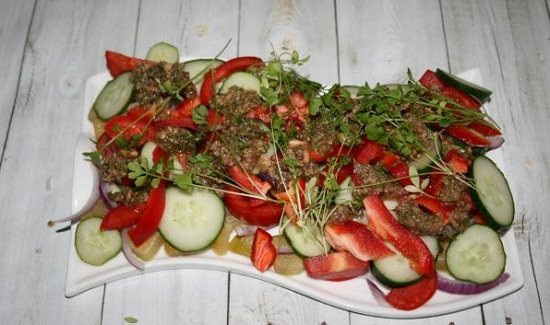
Ingredients:
- zucchini (preferably young) - one fruit;
- cucumber - one piece;
- tomato - one fruit;
- bell pepper (preferably red) – one piece;
- red onion - half a head;
- fresh basil;
- dill;
- salt;
- balsamic vinegar;
- olive oil - two tablespoons. spoons;
- garlic - one clove;
- lettuce cress.
Preparation:
- Peel the zucchini.
- Cut the zucchini pulp into medium-sized cubes.
- Heat a little refined vegetable oil in a frying pan.
- Add the zucchini and fry it until golden brown. Or you can bake the vegetable on the grill.

- Let the zucchini cool a little and place them nicely in one layer on a flat plate.
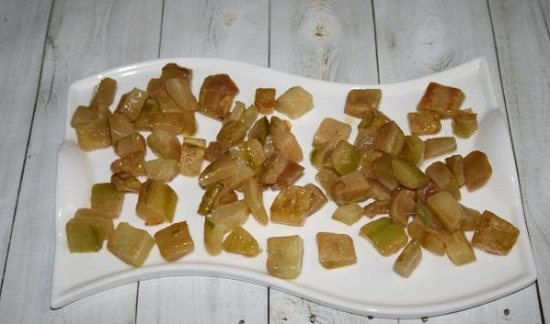
- Clean and rinse the onion. Chop it into thin half rings.
- Place the onions on top of the zucchini.

- Wash the tomato and cut into cubes.
- We also wash the cucumber and chop it into rings.
- Remove seeds and stalks from the pepper. We wash it and chop it into strips.
- Place the prepared vegetables on top of the onion layer.
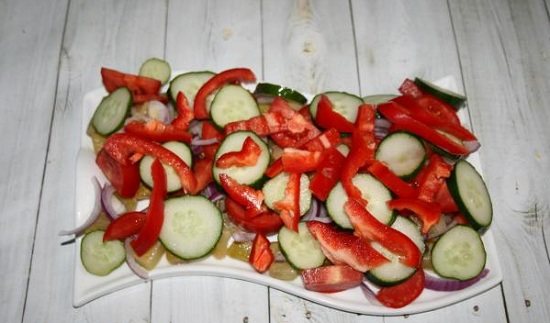
- Let's prepare the dressing for our treat. Peel the nuts from the shell. Grind them with a blender or coffee grinder.
- Place the chopped nuts in a bowl.
- Wash and chop the basil.
- Add the greens to the nut mixture.
- Wash and dry the dill. We chop it finely and send it to the ingredients of the dressing.
- Add 0.5 teaspoon. spoons of salt and black pepper.
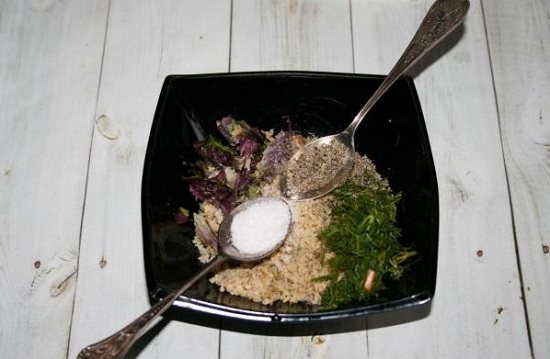
- Let's add just a couple of drops of balsamic vinegar.

- Let's add two tables. spoons of olive oil.

- Peel the garlic clove. After passing it through a press, add the garlic to the dressing.
- Stir it until it has a homogeneous structure.
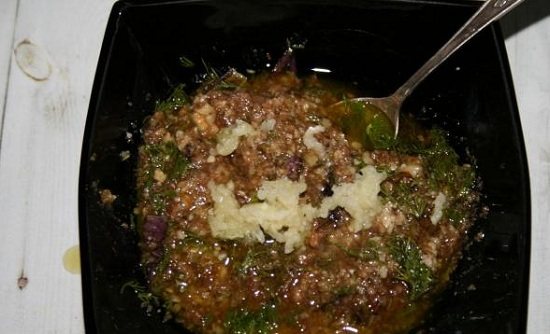
- Spoon the nut dressing on top of the snack.
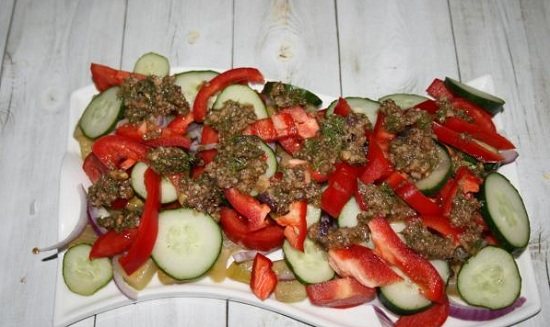
- All that remains is to sprinkle the treat with watercress.


